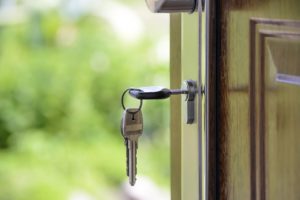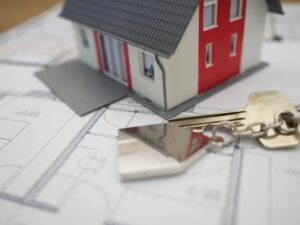
CC / Pixabay
(Update: I wrote the first version of this article in 2019. Who knew the typical house price in the United States would increase by 35% in three fast years.)
Eighteen months ago and with great reluctance, my husband and I decided to sell our home of 25 years for one-level living. With the master suite and laundry room on the first floor, some might consider our former house an ideal place to grow old; however, most of our spare time at home was spent two stories apart. He sat in his recliner in the basement, toggling between three TV shows at a time. Two stories up, we converted our daughter’s old bedroom into my office. It was the perfect spot for reading and writing as the sunlight filtered in through gauzy curtains by day and the evening brought the cozy glow of lamplight. That house was a pleasant, happy place–except for our growing inability to communicate with each other.
“Whaaaaat? Whaaaaat did you say?”
We would holler at each other with the full capacity of our lungs, me upstairs with him below, waiting for the other to make the trip to a point on the stairs where vocal reception was clear and the message could be received. Add to that, the growing realization the day would come when we would struggle to even climb the flights of stairs.
In addition, we were worried about the many boxes and tubs of mementos that filled the shelves from floor to ceiling in our basement storage. Much of this “stuff” came from our parents’ homes, some of which was passed down from their parents. They likely didn’t know what to do with it just as we didn’t (and still don’t). We suspected the next twenty years would pass even faster than the past four decades, and this “stuff” would become the burden of our children. This pressing problem was yet another reason to downsize.

CC / Pixabay
We contacted a realtor to list our old home and logged into Zillow many times in search of a new house. At the time, there were no one-level houses in our area that enticed us to part with our money. And the homes that appealed to us had not been maintained or updated. Tired flooring and cabinetry, worn HVAC, aging siding and roof—these were all issues we would have to resolve on top of the premium price the owners were requesting.
Understanding our dilemma, our realtor presented the idea of building a home that met all of our needs in a new subdivision. Not only would we be able to customize the home to our taste, new construction meant no structural problems to address or updates to make. In addition, the latest energy saving features offered in windows, appliances, and an HVAC system were also an incentive as we knew we would see some savings in our monthly energy bills.

CC / Pixabay
However, building a home meant moving into uncharted waters and we weren’t certain it was a direction we were prepared to sail.
As I Googled for articles with advice on whether it is better to buy or build, I was amazed at the number of articles floating around the Internet from certified financial experts who claim, most assertively, that renting rather than buying or building is a better option for retirees.
Renting? All our younger lives, the goal was to purchase a home. The mindset was firmly rooted in our heads by our parents and grandparents that renting is the equivalent of throwing money to the wind. Buying a home, however, establishes equity. I was gearing up for an argument with these professed know it alls—until I did the math. In our situation, and for those Boomers in similar situations, it actually appears just as financially sound to rent as it does to buy.
Here is why.
As we struggle to find our new normal after Covid, the average home price in the United States at this writing is $269,000. Let’s take that $269,000, for example, and consider the following two scenarios:
- Renting an apartment for 20 years and investing the $269,000. When we deduct the rent cost from the principal and interest we earn 20 years in the future, are we actually ahead?
- Investing that $269,000 in a home purchase and living rent-free for 20 years. How much do we actually save?
Scenario One: Our rental options in our community are limited, and a retirement complex for independent living is our best bet. The Retirement Living Information website reports “the cost of living in an independent living community ranges between $1,500 and $10,000 per month.”
A phone call to a local complex that best suited our needs revealed a two-bedroom apartment with garage space will cost approximately $2000 a month for the two of us, but this would include our electricity, gas, and water; furthermore, we wouldn’t pay property taxes on a home and we would only need to purchase an inexpensive renter’s policy for our belongings. If we used other income to pay our rent each month and invested that $269,000 at a projected return of 6% (experts’ consensus including CNBC market analyst Michael Santoli) for the next twenty years, our investment total would be $862,719. Deduct the cost of rent from this figure which a number of sources including Apartment Therapy estimate will increase approximately 3% annually ($2000 x 12 months = $24,000, compounded at 3% over twenty years = $644,888). Deduct the rent total from the investment total ($862,719 – $644,888) and we arrive at a remaining balance of $217,831 in our portfolio.
Scenario Two: On the other hand, if we purchased a modest home for $269,000 we might expect a projected annual home appreciation in Missouri of 2.69% according to a 20-year study conducted by Location Inc. Of course, determining the annual appreciation is a moving target as this 20 years study includes the 2007-2012 housing bubble fiasco when the value of real estate declined nationwide. In the last five years according to this study, Missouri housing prices have appreciated 4.77% percent annually, and in the last 12 months 4.62%
For the purpose of my scenario, let’s take a more conservative estimate of annual appreciation of 3% The estimated value of a $269,000 house would be in the range of $486,000 in twenty years–close to what we would have left in profict if we invested our $269,000 and rented an apartment. However, when we deduct the annual cost of taxes and insurance ($4500 taxes x 20 years plus $1800 insurance x 20 years =$126,000) and we figure in a modest estimate for electricity, gas, and water ($250 x 12 months x 20 years = $60,000) we are left with a value of $300,000 as we undoubtedly move on to other living options as 80-year-olds twenty years in the future. (This calculation excludes any costs for maintenance and necessary updating essential for attracting a future buyer.)

. CC / Pixabay
Of course, numerous variables could affect the actual monetary outcome, but in the instance of the two scenarios above, a mere $85,000 difference exists in favor of purchasing a home.
The two of us, however, never had any doubt about the value of purchasing rather than renting our next home. (In fact, we took the ultimate risk, withdrew investments to add to the $215,000 return on our previous home, and built a house.)
For us, owning a home has multiple advantages:
- No one knows what the future holds and that’s especially true with investments. If the stock market takes a prolonged downturn and somehow impacts our pensions, we may no longer afford the rent. However, our house is paid for. We have no worries of being evicted—although I may have to fashion a dress out of the drapes to persuade Rhett Butler to loan me the $4500 for the annual taxes.
- Although our children and their spouses have been gainfully employed in reliable fields for over a decade, there is always the chance that a family or a grandchild or two may need a place to live during a rough patch as the economy has its ups and downs. We have observed this happening in several instances with friends and acquaintances—and we would be able to provide that security for our children if the need arises.
- We love company. Having two guest rooms is essential so that our out-of- town children and grandchildren can visit comfortably with their own space. In addition, we are frequently an out- of-town stop for our extended family, traveling from one destination to the other.
- In twenty or twenty-five years, when we need to move on to an eldercare facility, the sale of our home remains part of our portfolio and a contribution to the estate we hope to pass on to our children.
- And finally, owning a home provides a comfortable sense of security. We had twenty-five years of remarkable memories in our previous home that were hard to leave behind. Even though we realized it was time to move to new place more conducive to our aging selves, we weren’t ready to trade the privileges that owning a house provides. There are many memories left to be made, if it’s God’s will–twenty more years of happy holidays, back porch barbeques, a garden, another dog, and as the after-school stop for our grandsons for the next decade.
So, the financial gurus may alter the numbers and tell us we are throwing our money away, but we are confident that our choice to purchase a home for the next stage of our lives makes perfect sense.
For further reading, access journalist Cassie Perera’s article “23 Scientific Reasons Why Owning is Better than Renting.” I am not sure that all reasons can be considered scientific, but they are certainly valid.
